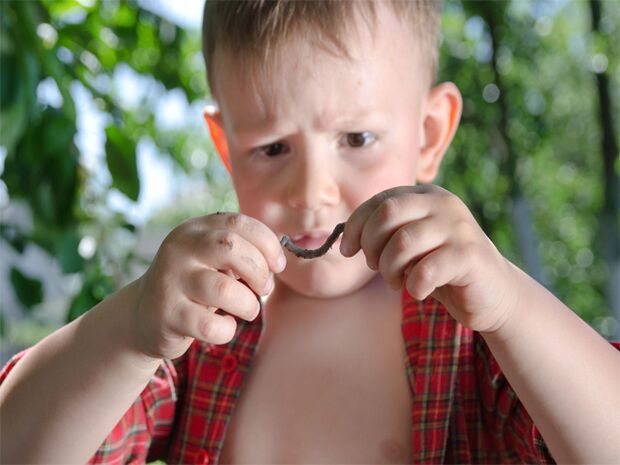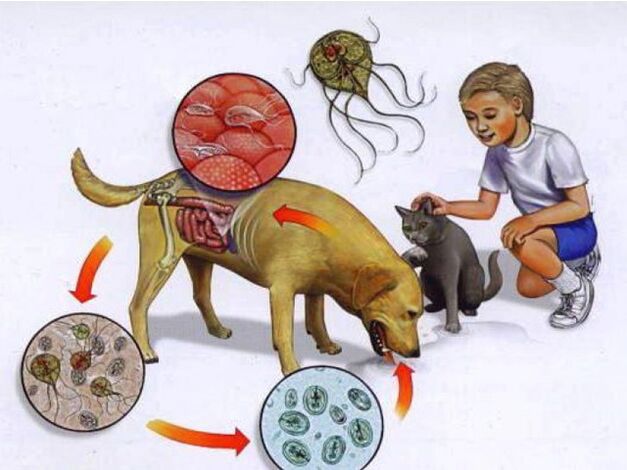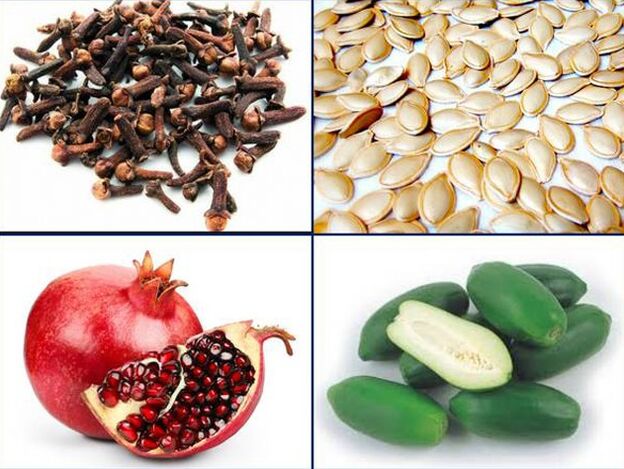Many forms of parasites enter and live in the human body. Worm infection in children is one of the most common diseases. They usually underestimate their severity. They take nutrients out of infant food, cause allergies, unmanageable poisoning, reduce immunity, and damage the abdominal organs.

According to statistics, more than half of the population is infected with parasites, and many more children are infected. The early stages of the disease are asymptomatic. Worms in children, the symptoms and treatment of which parents must learn and understand, sometimes live in humans for years, manifest themselves in nothing, and are only activated when immunity declines.
The spread of worms
The diseases that provoke the lower worms are called helminthiasis. No one is immune to them, often the infected themselves are to blame for the appearance of the worms. The extent of their prevalence is most affected by the climate. They are most comfortable in hot tropical countries. The number of parasites also depends on the socio-economic level: in underdeveloped regions with low levels of hygiene and medicine, many suffer from worm infection.
It is generally accepted that helminthiasis is a disease of low social strata living in unhealthy conditions and often in contact with the ground or animals - carriers of invasion. However, statistics refute this claim: in prosperous European countries, the study finds worms in a third of patients.
2 million cases of infection are diagnosed each year, with 20 million based on anthelmintic sales. 80% of them are children. The helminths are viable, fertile, and a female lays 200, 000 eggs a day.
Types of worms
There are a wide variety of worms - more than 300, 70 of which are typical of our region, the rest are brought in by travelers from exotic countries. All types of parasites in the human body fall into three major categories:
- nematodes belonging to the class of roundworms, most commonly observed in infants (these include the fungal worm, the whipworm, the trichinella, the tapeworm);
- for gluing (flat) worms classified as cestodes (these include tapeworms, tapeworms, echinococcus);
- against trematodes or parasitic parasites that live and multiply in the gut but enter various human organs through the bloodstream. Usually, the intestines near the stomach, liver, and gallbladder are the most infected, but the worms reach the muscle tissue, the lungs, and even the brain and heart.
In terms of prevalence, in the first place are the needle worms, which are round in diameter and have small parameters - up to 6 mm. They are located in the lower part of the colon. More than 24, 000 species of nematodes are known. The female can lay 150, 000 eggs a day. Their systematic movement and reproduction in the gut abroad is the main reason for the risk of secondary infection caused by enterobiasis.
Ascaris infection, which ranks second in prevalence, is inherent in preschoolers and younger schoolchildren. Adult worms look menacing: they grow up to 30 cm. The female lays about 100, 000 eggs a day. The larvae get into the body with unwashed hands, dirty food and water. Through the bloodstream, they reach all parts of the child’s body and settle in them. This type of helminthiasis is quite dangerous to the body of an unformed child. Ascariasis is often responsible for an allergic reaction in children.
Trichinella is not so common in children. These are the pathogens of trichinosis, to which the lightning fast passage of eggs through the body, causing muscle tissue damage. The consequences of trichinosis are peritonitis, intestinal bleeding.
Sources and methods of invasion
Prevention of worm infection in children is possible if you understand the information about the transmission of worms. In fact, there are many possibilities for them to penetrate the human body. Most people come into contact through household or nutrition.
Strict adherence to the principles of personal hygiene is believed by many to protect against helminthiasis. Unfortunately, this opinion is wrong. Children are most at risk of infection due to close contact with the perpetrators. Each source of invasion has its own characteristics:

- through the contact-household route, the larvae enter the body through infected people, things, animals;
- the alimony method is the culprits of unwashed palms, water of doubtful purity, infected food supplies;
- the worms in the transmission route come from blood-sucking insects;
- active (percutaneous) - the testicles of the worms overcome the connective tissues or skin from the soil or reservoirs during bathing. Sometimes the larvae in the air get into the respiratory system along with the dust particles.
Despite the racial diversity of worms, children become infected with them in much the same way. Eggs, larvae, parts of the body, or the whole parasite, when they reach humans, begin to feed and multiply, their numbers increase intensively in the absence of therapy. The health of an infected person deteriorates, he will be the culprit in transmitting the invasion to others.
The eggs of the most common worms - spindle worms, needle worms - covered with a sticky capsule stick firmly to the surface and are kept there. The spread will happen soon. On the palms of the hands and the fingers, eggs accumulate under the nails, from where they are transferred to everyday things used by man. This infects all family members and the immediate environment.
Certain types of worms have the ability to penetrate the placenta and infect the fetus inside the womb. Catching an infection from a mother with enterobiasis, possibly during childbirth. A breastfeeding baby can become infected from sick relatives, although the disease does not spread through breast milk. There are also non-standard cases of transmitting worm eggs from an infected person: during sexual contact or kissing, and contraception is useless in this case.
It is impossible to completely protect yourself from helminthiasis: their larvae live everywhere. However, there is an opportunity to reduce the risk of disease for those who adhere to hygiene requirements, consume heat-treated foods, and regularly participate in worm prevention.
Identification of helminth samples
Infection with parasites is most common during the warm season because babies are exploring their surroundings vigorously, spending all day outdoors, splashing in the sandpit, water reservoirs, eating berries and fruits right from the branches without having to worry about washing their hands. and fruits.
In adults, worms have to force a number of barriers before they can enter the body: saliva in the mouth, an acidic environment in the stomach, and immune defense in the gut. In children, protection is much weaker, making helm patterns easier to defeat. Parents should be aware of the signs of infection in their children. Most people are aware of the difference, such as gnashing their teeth at night, though that’s not the only indicator. How to understand that a child has worms? Pay attention to the symptoms.
Common symptoms of worms
The presence of worms in the child's body poisons them with waste products, so increased fatigue, dizziness, refusal to eat, and whims are considered to be one of the main symptoms of the infection. The following general features are typical:
- allergic skin reaction - rash, hives, eczema;
- digestive complications - alternating constipation and diarrhea, bloating, nausea, pain in the navel;
- decrease in protective immunity, recurrent cold, addition of fungal infection;
- manifestation of an allergic-toxic response to vaccination;
- decreased hemoglobin.
Parents should be especially alert for these signs in infants, such as when acute respiratory infections or thrush are difficult to heal. In such cases, it is logical to assume the presence of helminth invasion.
In addition to the general symptoms of an infection caused by worms, there are also unique signs of the presence of a certain parasite in the child.
Symptoms of Ascaris
The most important symptom of ascariasis in children is a dry cough with worms in children, combined with a rash, and two weeks later - the manifestation of general indicators of intoxication, abdominal pain. A distinctive sign is the variability in the child’s neural and mental well-being.
Pinworm symptoms
Pinworm infection is declared as dry mouth. Infected children complain of anus irritation, especially at night. The child scratches this surface, which is full of inflammation. In girls, these symptoms are complemented by enuresis and vulvovaginitis. Appetite changes, stools upset, baby coughs, does not sleep well, nervous system upset.
Manifestation of signs of other worms
Trichocephalosis is common in temperate, subtropical climates: whipworms prefer moisture. The signs are not quite typical: the pain is reminiscent of an appendicitis, the baby often has a stool drive, and symptoms of colitis can also be observed. This can result in rectal prolapse as well as severe anemia.
Hookworms love moisture and warmth, they also like subtropical, tropical climates, especially the Krasnodar region. The symptom is a rash at the site where the parasite penetrates the skin. Complicated by severe anemia.
Dogs are carriers of toxocariasis, a disease that is ubiquitous. Symptoms include:
- abdominal pain;
- decreased vision;
- nervous system disorders;
- allergic reactions.
It can complicate bronchitis, pneumonia, bronchial asthma.
Echinococcosis is on the rise everywhere - on every continent except Antarctica. For a long time running latently, the symptoms are nervous disorders, headaches. Severe consequences are disorders of the brain, lungs, liver, heart and kidneys. A helminthic invasion in children, the symptoms of which are life-threatening for the child, is treated with surgery.
Trematodosis (opisthorchiasis, fascioliasis) is widespread on the shores of the seas, in watersheds, and the main source of infection is untreated fish. Symptoms of the disease include jaundice, muscle aches, fever and allergic rash. The disease is exacerbated by ulcerative gastroduodenitis, cirrhosis of the liver, purulent cholangitis, peritonitis, chronic hepatitis.
The symptoms of childhood helminthiasis are polymorphic and suitable for many diseases, so it is difficult to use only the clinical picture to make a diagnosis. Laboratory research - analysis of worm eggs that needs to be repeated several times - gets more realistic results.
Age characteristics of the disease
Worms in an infant
Helmsins are usually found in one- and two-year-old preschoolers. Babies are rarely infected with parasites from an infected mother - during intrauterine development, during childbirth, during feeding. This usually occurs after 6 months, with the onset of supplemental feeding, active crawling. The child does not lack any microbes, bacteria or parasites. Helms are much more difficult to detect in infants than in children of other ages. Symptoms and signs of worms in children include:
- anxiety in the child, disturbed sleep;
- persistent fatigue, lethargy, general weakness;
- irritation and inflammation in the anal area and in girls - around the genitals;
- digestive disorders: constipation, diarrhea, vomiting, bloating, colic;
- dizziness with body poisoning;
- weight loss, refusal to eat, although there are exceptions;
- pallor, white skin,
- shadows under the eyes;
- rashes on the body, especially on the thighs;
- insignificant temperature rise;
- exacerbation of chronic diseases;
- regular cough independent of respiratory disease.
Such symptoms in an infant may indicate not only the invasion of helminths but also many other diseases. Therefore, repeated stool tests should be performed at regular intervals to confirm the diagnosis.
The symptoms of worms in children older than 2 years are mostly similar to the common symptoms of worms. The entry of larval and developing forms of worms into the child's body can cause great damage to health, as the protection of babies is only just beginning to develop, and the child cannot resist unwanted aggressors. The risk is increased by the fact that children are willing to taste everything without knowing the principles of hygiene. Regardless of the type of worms, the manifestations of helminthiasis in biennials are similar. This:
- rash on the skin;
- swollen lymph nodes;
- abundant saliva flow during sleep at night;
- a sudden increase or decrease in appetite accompanied by a decrease in body weight;
- unexpected nausea, bowel problems.
There are also common signs: irritation in the anus, in girls - in the genital area, poisoning, fatigue, decreased immunity, disturbance of nervous processes.
The symptoms of worms in 3-year-old children are the same as before.
An important factor in the invasion of 3-5 year old children is visits to childcare facilities and contact with worm-infected pets. Children become infected with less common pathogens of helminthiasis while traveling to or from relatives in exotic countries. The rapid penetration of the eggs of larvae and parasites into the child's body is facilitated by:
- lack of vitamins, useful elements;
- lack of food-derived protein;
- poor quality food;
- decreased immunity.
The symptoms of worms are similar in 5-year-old children. On Dr. Komarovsky’s website, you can see photos and videos of the treatment and prevention of worms, as well as read patient reviews.
Diagnosis of the disease
The appearance of the first symptoms of helminthic invasion indicates the need for special tests. In clinical practice, due attention is paid to the diagnosis of helminthiasis among preschoolers and elementary school students. The presumed diagnosis should be confirmed by laboratory research techniques:
- a clinical blood test to detect antibodies against certain pathogens in parasites;
- scraping of enterobiasis and analysis of feces three times for correct diagnosis;
- analysis evaluating intestinal microflora.
The general blood test looks at the color marker. The diagnosis is confirmed, provided that its index is higher than that found, the number of eosinophils increases, hemoglobin, on the contrary, decreases, and anemia is expressed. An enzyme-linked immunosorbent assay for the detection of parasites should be performed on an empty stomach. The effect is almost one hundred percent unmistakable, reliable, it can even identify the type of worms, the damage caused by worms in the baby's body.
Analysis of helminth eggs and dysbacteriosis is based on a stool test. Stool tests for worms do not always give results, so they are repeated. Biological testing of sputum, bile, urine, and feces is used to detail the diagnosis. Opisthorchiasis is determined by examining the intubation content of the intestine and duodenum.
Other diagnostic techniques include internal organ ultrasound, x-ray, computed tomography, MRI. They help the practitioner to determine the presence of helminth samples in the internal organs. The combination of these tests allows the diagnosis of enterobiasis to be confirmed or denied. The sooner the diagnosis is made and the worms are started to be treated in children, the less the baby’s health will suffer.
Healing from invasions by the traditional method
The serious consequences of helminthiasis force us to take a responsible approach to treating the disease, to contact professionals - a parasitologist or a pediatrician. The medical treatment consists of 3 stages.
The preparation phase consists of the assignment of sorbents and antihistamines to cleanse the baby’s body of toxic substances that have accumulated during the life cycle of the parasites.
Anthelmintic therapy consists of the selection of drugs depending on age, type of pathogen, and stage of the disease. Generally, a single dose of the drug is prescribed in the form of a tablet or suspension. After 2 weeks, the course is repeated.
Anthelmintics are very toxic, so the greatest possible precautions should be taken when prescribing them so as not to harm the health of the child. Dosage is extremely important. Self-medication is not recommended and should be prescribed by a doctor, who may prescribe a combination of medicines. It is recommended that you read the contraindications to the anthelmintic carefully.
The cleansing scheme is performed after the use of anthelmintic drugs, when the parasites are killed and excreted in the feces. At this point, huge amounts of toxic substances get into the baby’s body. For cleansing, enemas require the administration of absorbers and choleretic drugs. Blood and stool tests are needed again after the course of treatment. In case of complications, the baby is registered for 3 years.
Folk remedies
Herbalists look back on a long history of protection against parasitic worms. Mainstream medicine recognizes the benefits of some of these therapies. However, not all of them give guaranteed results. It is advisable to discuss their use with your doctor. The following folk recipes are considered the most effective:

- use of pumpkin seeds;
- use of hemp, pumpkin, flaxseed oil;
- garlic enema supplemented with milk;
- use of soda enema;
- beet juice;
- tansy infusion: 3 tbsp. l. the dance is poured into a glass of boiling water, adhered to it for one hour, and then the infusion is given to the child to drink 1 liter of dessert. three times a day; overdose is unacceptable to avoid depression in the nervous system;
- birch tar;
- herbal infusions, wormwood enemas.
Preventive measures
In order to protect your child from helminthic invasions, certain rules must be strictly followed:
- teach your baby to wash their hands thoroughly before eating and after walking;
- cut the nail plates systematically;
- change your child's costume more often;
- keep household items and toys clean;
- it is not desirable to keep tetrapods in the house;
- teach him not to take fingers, toys to walk in his mouth;
- once a year to perform prophylaxis for the whole family in the form of medication.
Worm infection is a serious problem. The disease is quite common in the world and children are particularly susceptible to it. The disease can last for years and cause huge damage to your baby’s health. During their existence, worms emit toxins, which lead to the appearance of various diseases that cause a lot of discomfort and discomfort to the child. This is why parents need to notice the symptoms in time and treat them with the help of a professional.






































